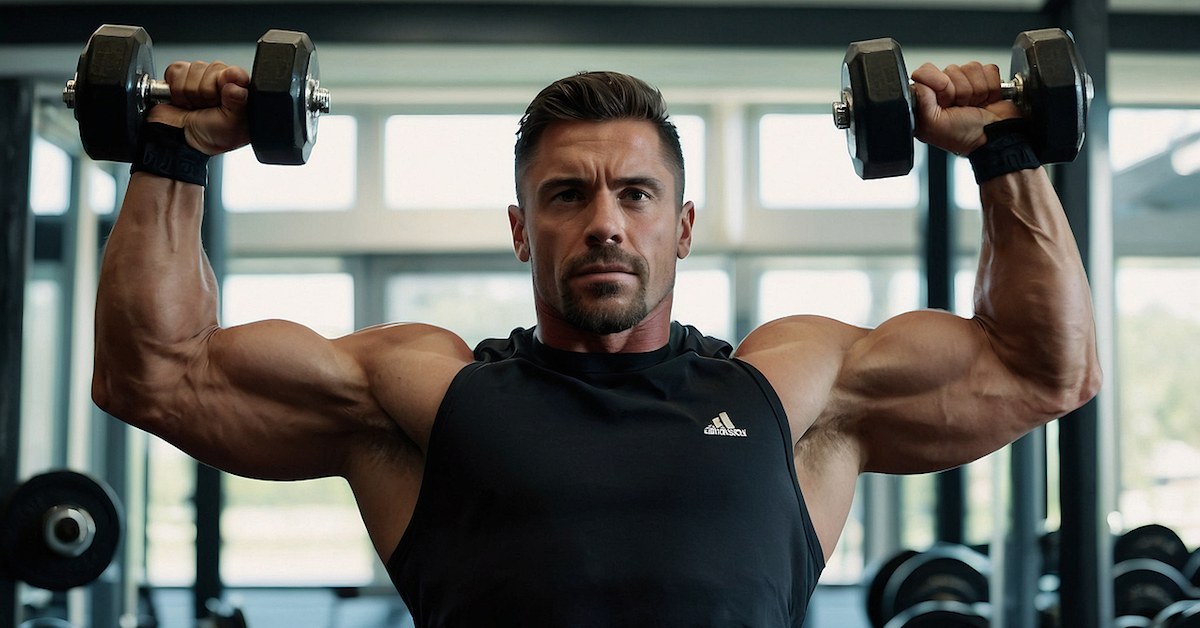Over the years, various techniques have been advanced in strength training. Some have merit, many do not! Partials conducted in the strongest range for an extended period of time is one “antiquated” example. This was advocated as a method to increase the amount of work performed in a given unit of time. Such training would be superior to all others if we only considered half of the work equation. The problem, of course, is that work is equal to force times distance. Sure, you may be able to bench 405 pounds for 3 or 4 inches, but compare that to 315 pounds for 18 to 20 inches and then tell me who performs more work. Go ahead, do the math!
Techniques that actually produce results will stand the test of time, others will simply fade away. The superset is a classic method that has been used “successfully” for decades. Today, I’ll present you with four superset versions (agonist, antagonist, pre-exhaustion, and post-exhaustion) in one routine. This system works well for both hypertrophy and body composition changes. In other words, you can use supersets to get big and lean at the same time!
Terminology
A superset involves performing a set of two exercises in a row with little to no rest in between for the same muscle group (agonist superset) or opposite muscle groups (antagonist superset). An upright row followed immediately with a lateral raise is an example of an agonist superset and a leg extension followed immediately with a leg curl is an example of an antagonist superset.
Pre-exhaustion involves performing an isolation (single-joint) movement prior to a compound (multi-joint) movement for the same muscle group with very little rest in between. For instance, you would perform flyes just prior to the bench press to pre-exhaust the pectorals. During the bench press, the triceps and deltoids would then assist allowing you to completely fatigue the pecs.
Post-exhaustion involves the reverse order (i.e., performing a compound movement just prior to an isolation movement for the same muscle group). The advantage of this system over pre-exhaustion is that greater workloads can be achieved, but both methods are effective for hypertrophy.
A staggered pairing occurs when you sequence two muscle groups from different parts of the body in a superset fashion such as alternating between squats and chin-ups. This approach improves recovery (i.e., as you fatigue the lower body, the upper body recovers, and vice versa) and is effective for body composition changes.
The routine I’m about to present to you does not use staggered pairing per se. However, by sequencing superset pairs in a staggered fashion (i.e., 3 sets of a lower body pair followed by 3 sets of an upper body pair and so on), similar results can be achieved. This will allow us to alternate between agonist (same) and antagonistic (opposite) body parts/movements (for strength and hypertrophy) as well as between upper and lower body exercises (for body composition) to experience the best of all worlds!
The Program
Now that we have a basic understanding of supersets, let’s take a look at the program and then we’ll discuss the details afterward.
Day 1 – Post-Exhaustion Agonist Superset
A1. Front Squat: 3 x 4-6 @ 5010, 10s
A2. Seated Leg Extension: 3 x 10-12 @ 2010, 120s
B1. Wide-Grip Pull-Up: 3 x 4-6 @ 5010, 10s
B2. Semi-Stiff-Arm Pulldown: 3 x 10-12 @ 2010, 120s
C1. Snatch Podium Deadlift: 3 x 4-6 @ 5010, 10s
C2. Lying Dorsiflexed Leg Curl: 3 x 6-8 @ 4010, 120s
D1. Incline Barbell Press: 3 x 4-6 @ 5010, 10s
D2. Flat Rope Flye: 3 x 10-12 @ 2010, 120s
E1. Sicilian Crunch: 3 x 4-6 @ 5010, 10s
E2. Supine Cable Knee-In: 3 x 10-12 @ 2010, 120s
Day 2 – Antagonist Superset Sequence #1
A1. Standing Good Morning: 3 x 8-10 @ 3010, 10s
A2. Low-Decline Sit-Up: 3 x 10-12 @ 20X0, 120s
B1. Flat Close-Grip Neck Press: 3 x 6-8 @ 3210, 10s
B2. Seated Rope Row to Neck: 3 x 10-12 @ 2010, 120s
C1. Hanging Leg Raise: 3 x 8-10 @ 30X0, 10s
C2. Reverse Hyperextension: 3 x 10-12 @ 20X0, 120s
D1. Seated Twisting Offset-Grip Dumbbell Curl: 3 x 8-10 @ 3010, 10s
D2. Standing Rope Pressdown: 3 x 10-12 @ 2010, 120s
E1. Standing Calf Raise: 3 x 8-10 @ 2210, 10s
E2. Seated Leg Curl Tibialis Raise: 3 x 15-20 @ 1010, 120s
Day 3 – Pre-Exhaustion Agonist Superset
A2. Seated Leg Extension: 3 x 8-10 @ 3010, 10s
A1. Heel-Elevated Back Squat: 3 x 8-10 @ 3010, 120s
B2. Decline EZ-Bar Pullover: 3 x 8-10 @ 3010, 10s
B1. Wide-Grip Cable Pulldown: 3 x 10-12 @ 2010, 120s
C1. Lying Plantarflexed Leg Curl: 3 x 6-8 @ 4010, 10s
C2. Bent-Knee Deadlift: 3 x 8-10 @ 3010, 120s
D2. Flat Rope Flye: 3 x 8-10 @ 3010, 10s
D1. Incline Neutral-Grip Dumbbell Press: 3 x 8-10 @ 3010, 120s
E2. Supine Cable Knee-In: 3 x 8-10 @ 3010, 10s
E1. Swiss Ball Crunch: 3 x 10-12 @ 2010, 120s
Day 4 – Antagonist Superset Sequence #2
A2. High-Decline Sit-Up: 3 x 8-10 @ 30X0, 10s
A1. Wide-Stance Good Morning: 3 x 10-12 @ 2010, 120s
B2. Seated Pronated-Grip Cable Row: 3 x 8-10 @ 30X0, 10s
B1. Low-Decline Close-Grip Bench Press: 3 x 10-12 @ 20X0, 120s
C2. Reverse Hyperextension: 3 x 8-10 @ 30X0, 10s
C1. Hanging Knee Raise: 3 x 12-15 @ 20X0, 120s
D2. Decline Twisting Dumbbell Triceps Extension: 3 x 8-10 @ 30X0, 10s
D1. Standing Twisting Rope Curl: 3 x 10-12 @ 20X0, 120s
E2. Seated Cable Tibialis Raise: 3 x 10-12 @ 1012, 10s
E1. Seated Calf Raise: 3 x 12-15 @ 2010, 120s
The Parameters
Sometimes small things can make a big difference. The 10 seconds between exercises of a superset gives you just enough time to get to the next station and go. This short rest interval will also allow some energy to be recovered for better performance on the second exercise. Unfortunately, this form of training is not always practical in a busy gym. Try to plan your workouts around non-peak hours.
The frequency is 4 days a week. For those who prefer their weekends free, follow this schedule:
Day 1 – Monday, Day 2 – Tuesday, Day 3 – Thursday, Day 4 – Friday
If you have more time to train on the weekend, then follow this schedule:
Day 1 – Tuesday, Day 2 – Thursday, Day 3 – Saturday, Day 4 – Sunday
For novices, you could alter the routine and use the exact same movements on Days 3 and 4 as you do on Days 1 and 2 respectively. Simply reverse the order of exercises within each superset pair on those workouts and the program will work well. For advanced trainees, however, greater diversity and more recovery time is necessary with this method. Therefore, many of the exercises will differ somewhat on Days 3 and 4, particularly the multi-joint movements. Performing a pull-up as the first exercise of a superset pair is fine, but it’s not quite as “exciting” as the second exercise especially if you’re over 200 pounds!
This type of training will often require load reductions on subsequent sets to maintain the rep range. Some slow-twitch individuals may get away with the same loads throughout, but most fast-twitch individuals will not. A rep range is given as a buffer to accommodate fatigue and gauge how to proceed on the following set. For instance, if 10-12 reps are prescribed and you perform 12 reps on the first set, use the same weight for the next set. If you drop to 10 reps, lower the weight by 5-10% for the third set. If on the second set you perform 11 reps or happen to get 12 again (which usually means that you did not use a maximum load on the first set), then stick with the same weight on the final set. However, if you only muster 10 reps on your first set, you must lower the weight (again by 5-10%) on the next set. It’s highly unlikely that you’ll achieve the prescribed number of reps otherwise. With experience (or a decent trainer by your side), you’ll know how to manipulate the loads appropriately.
A Super Method for Super Results!
Unlike extended partial training, supersets truly do allow more work in a given period of time especially if the exercises are performed in full range of motion. Don’t mess with success. If something works, stick with it. You’ll get big and lean with a superset routine and trust me, that never gets old!



